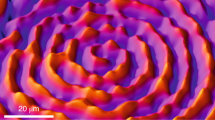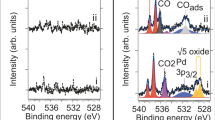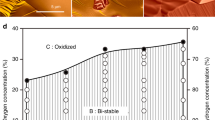Abstract
Catalytic processes on surfaces have long been studied by probing model reactions on single-crystal metal surfaces under high vacuum conditions. Yet the vast majority of industrial heterogeneous catalysis occurs at ambient or elevated pressures using complex materials with crystal faces, edges and defects differing in their catalytic activity. Clearly, if new or improved catalysts are to be rationally designed, we require quantitative correlations between surface features and catalytic activity—ideally obtained under realistic reaction conditions1,2,3. Transmission electron microscopy4,5,6 and scanning tunnelling microscopy7,8 have allowed in situ characterization of catalyst surfaces with atomic resolution, but are limited by the need for low-pressure conditions and conductive surfaces, respectively. Sum frequency generation spectroscopy can identify vibrations of adsorbed reactants and products in both gaseous and condensed phases9, but so far lacks sensitivity down to the single molecule level. Here we adapt real-time monitoring of the chemical transformation of individual organic molecules by fluorescence microscopy10,11,12 to monitor reactions catalysed by crystals of a layered double hydroxide immersed in reagent solution. By using a wide field microscope, we are able to map the spatial distribution of catalytic activity over the entire crystal by counting single turnover events. We find that ester hydrolysis proceeds on the lateral { } crystal faces, while transesterification occurs on the entire outer crystal surface. Because the method operates at ambient temperature and pressure and in a condensed phase, it can be applied to the growing number of liquid-phase industrial organic transformations to localize catalytic activity on and in inorganic solids. An exciting opportunity is the use of probe molecules with different size and functionality, which should provide insight into shape-selective or structure-sensitive catalysis13,14,15 and thus help with the rational design of new or more productive heterogeneous catalysts.
} crystal faces, while transesterification occurs on the entire outer crystal surface. Because the method operates at ambient temperature and pressure and in a condensed phase, it can be applied to the growing number of liquid-phase industrial organic transformations to localize catalytic activity on and in inorganic solids. An exciting opportunity is the use of probe molecules with different size and functionality, which should provide insight into shape-selective or structure-sensitive catalysis13,14,15 and thus help with the rational design of new or more productive heterogeneous catalysts.
This is a preview of subscription content, access via your institution
Access options
Subscribe to this journal
Receive 51 print issues and online access
$199.00 per year
only $3.90 per issue
Buy this article
- Purchase on Springer Link
- Instant access to full article PDF
Prices may be subject to local taxes which are calculated during checkout




Similar content being viewed by others
References
Thomas, J. M. & Thomas, W. J. Principles and Practice of Heterogeneous Catalysis (Wiley-VCH, Weinheim, 1996)
Thomas, J. M. Catalysis and surface science at high resolution. Faraday Discuss. 105, 1–31 (1996)
Ertl, G., Knözinger, H. & Weitkamp, J. Handbook of Heterogeneous Catalysis (Wiley-VCH, Weinheim, 2000)
Hansen, T. W. et al. Atomic-resolution in situ transmission electron microscopy of a promoter of a heterogeneous catalyst. Science 294, 1508–1510 (2001)
Hansen, P. L. et al. Atom-resolved imaging of dynamic shape changes in supported copper nanocrystals. Science 295, 2053–2055 (2002)
Helveg, S. et al. Atomic-scale imaging of carbon nanofibre growth. Nature 427, 426–429 (2004)
Zambelli, T., Barth, J. V., Wintterlin, J. & Ertl, G. Complex pathways in dissociative adsorption of oxygen on platinum. Nature 390, 495–497 (1997)
Wolff, J., Papathanasiou, A. G., Kevrekidis, I. G., Rotermund, H. H. & Ertl, G. Spatiotemporal addressing of surface activity. Science 294, 134–137 (2001)
Dellwig, T., Rupprechter, G., Unterhalt, H. & Freund, H. J. Bridging the pressure and materials gap: High pressure sum frequency generation study on supported Pd nanoparticles. Phys. Rev. Lett. 85, 776–779 (2000)
Lu, H. P., Xu, L. & Xie, X. S. Single-molecule enzymatic dynamics. Science 282, 1877–1882 (1998)
Velonia, K. et al. Single-enzyme kinetics of CALB-catalyzed hydrolysis. Angew. Chem. Int. Edn Engl. 44, 560–564 (2005)
Flomenbom, O. et al. Stretched exponential decay and correlations in the catalytic activity of fluctuating single lipase molecules. Proc. Natl Acad. Sci. USA 102, 2368–2372 (2005)
Corma, A. Inorganic solid acids and their use in acid-catalyzed hydrocarbon reactions. Chem. Rev. 95, 559–614 (1995)
Boudart, M., Aldag, A., Benson, J. E., Dougharty, N. A. & Harkins, C. G. On the specific activity of platinum catalysts. J. Catal. 6, 92–99 (1966)
Bernasek, S. L., Siekhaus, W. J. & Somorjai, G. A. Molecular-beam study of hydrogen-deuterium exchange on low- and high-Miller-index platinum single-crystal surfaces. Phys. Rev. Lett. 30, 1202–1204 (1973)
Fogg, A. M., Freij, A. J. & Parkinson, G. M. Synthesis and anion exchange chemistry of rhombohedral Li/Al layered double hydroxides. Chem. Mater. 14, 232–234 (2002)
Cavani, F., Trifiro, F. & Vaccari, A. Hydrotalcite-type anionic clays: preparation, properties and applications. Catal. Today 11, 173–301 (1991)
Cai, H., Hillier, A. C., Franklin, K. R., Nunn, C. C. & Ward, M. D. Nanoscale imaging of molecular adsorption. Science 266, 1551–1555 (1994)
Sels, B. et al. Layered double hydroxides exchanged with tungstate as biomimetic catalysts for mild oxidative bromination. Nature 400, 855–857 (1999)
Sels, B. F., De Vos, D. E. & Jacobs, P. A. Hydrotalcite-like anionic clays in catalytic organic reactions. Catal. Rev. 43, 443–488 (2001)
Noji, H., Yasuda, R., Yoshida, M. & Kinosita, K. Direct observation of the rotation of F1-ATPase. Nature 386, 299–302 (1997)
Roelofs, J. C. A. A., Lensveld, D. J., van Dillen, A. J. & de Jong, K. P. On the structure of activated hydrotalcites as solid base catalysts for liquid-phase aldol condensation. J. Catal. 203, 184–191 (2001)
Abelló, S. et al. Aldol condensations over reconstructed Mg-Al hydrotalcites: structure–activity relationships related to the rehydration method. Chem. Eur. J. 11, 728–739 (2005)
Corma, A., Iborra, S., Miquel, S. & Prim, J. Production of food emulsifiers, monoglycerides, by glycerolysis of fats with solid base catalysts. J. Catal. 173, 315–321 (1998)
Engel, D. J., Malloy, T. P., & Nickl, P. K. Transesterification using metal oxide solid solutions as the basic catalyst. US Patent 5,350,879 (1993).
Watanabe, Y. & Tatsumi, T. Hydrotalcite-type materials as catalysts for the synthesis of dimethyl carbonate from ethylene carbonate and methanol. Micropor. Mesopor. Mater. 22, 399–407 (1998)
Abelló, S. et al. Aldol condensations over reconstructed Mg–Al hydrotalcites: structure–activity relationships related to the rehydration method. Chem. Eur. J. 11, 728–739 (2005)
Hellriegel, C., Kirstein, J. & Bräuchle, C. Tracking of single molecules as a powerful method to characterize diffusivity of organic species in mesoporous materials. N. J. Phys. 7, 1–14 (2005)
Hell, S. W. Toward fluorescence nanoscopy. Nature Biotechnol. 21, 1347–1355 (2003)
Martens, J. A. et al. Evidences for pore mouth and key–lock catalysis in hydroisomerization of long n-alkanes over 10-ring tubular pore bifunctional zeolites. Catal. Today 65, 111–116 (2001)
Serna, C. J., Rendon, J. L. & Iglesias, J. E. Crystal-chemical study of layered [Al2Li(OH)6]+X-.nH2O. Clays Clay Miner. 30, 180–184 (1982)
Acknowledgements
M.B.J.R. thanks the Institute for the Promotion of Innovation through Science and Technology in Flanders (IWT-Vlaanderen) for a fellowship, B.F.S. thanks the FWO-Flanders for a post-doctoral fellowship and the KUL for a guest professor position. This work was performed within the framework of the IAP-V-03 programme ‘Supramolecular Chemistry and Catalysis’ of the Belgian Federal government and of GOA-2/01.
Author information
Authors and Affiliations
Corresponding authors
Ethics declarations
Competing interests
Reprints and permissions information is available at npg.nature.com/reprintsandpermissions. The authors declare no competing financial interests.
Supplementary information
Supplementary Video 1
Wide field fluorescence images of C-FDA transesterification on a coverglass functionalized with a 1:10,000 DMAPTS:PTS mixture. (AVI 3484 kb)
Supplementary Video 2
Wide field fluorescence image of the catalytic transesterification of C-FDA on an individual LDH particle. (AVI 9700 kb)
Supplementary Video 3
Wide field fluorescence image of the catalytic transesterification of FDA on an individual LDH particle. (AVI 3420 kb)
Supplementary Video 4
Detail of the diffusion of single 5-carboxyfluorescein product molecules on the basal plane of an LDH. (AVI 2007 kb)
Supplementary Notes
This file contains Supplementary Data on the use of fluorescence microscopy for in situ study of organic transformations on mordenite zeolites. This file also contains a Supplementary Discussion and Supplementary Figures. (DOC 490 kb)
Supplementary Legends
Text to accompany the above Supplementary Videos. (DOC 30 kb)
Rights and permissions
About this article
Cite this article
Roeffaers, M., Sels, B., Uji-i, H. et al. Spatially resolved observation of crystal-face-dependent catalysis by single turnover counting. Nature 439, 572–575 (2006). https://doi.org/10.1038/nature04502
Received:
Accepted:
Issue Date:
DOI: https://doi.org/10.1038/nature04502
This article is cited by
-
Optical sequencing of single synthetic polymers
Nature Chemistry (2024)
-
Identifying the active sites in unequal iron-nitrogen single-atom catalysts
Nature Communications (2023)
-
The unique spontaneous polarization property and application of ferroelectric materials in photocatalysis
Nano Research (2023)
-
The concept of active site in heterogeneous catalysis
Nature Reviews Chemistry (2022)
-
Hole utilization in solar hydrogen production
Nature Reviews Chemistry (2022)
Comments
By submitting a comment you agree to abide by our Terms and Community Guidelines. If you find something abusive or that does not comply with our terms or guidelines please flag it as inappropriate.



